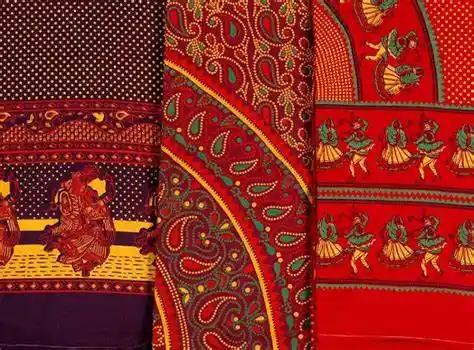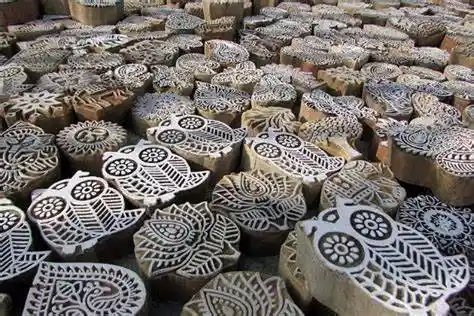Sanganeri Print Of Rajasthan
Art can be found in so many variants. It can be found in music, dance, sketching, painting, and whatnot. Just like that, one very beautiful form of art is the hand-block painting technique of Sanganer, Rajasthan.

Sanganeri print; image source: Utsavpedia.com
Printing is now universally recognized as a renowned art form. Evidence of printed clothes can be traced back to 2500 B.C, and various kinds of drawings were depicted on fabric. It is believed that India and China were the first countries to use the block-painting technique on clothes. Saganeri hand-block painting originated in the Sanganer Village located near Jaipur, Rajasthan. It has been in making for more than 5 centuries and holds a significant place in the world of artisans and craftsmen.
Several kinds of patterns and designs with vibrant colors are the factors that distinguish this hand-block painting technique from others.
Sanganer was not known as a printing center before the 17th century. Earlier, it was known for plain and dyed clothing. It was during the time when constant wars were going on between the Mughals and the Marathas which forced the craftsmen from Gujarat to move to Rajasthan. Here, this printing technique emerged, developed, and gained phenomenal significance.
The prominent dyes used in Sanganeri print are so unique that they became one of the most exported items of East India Company.
The techniques of this art form were passed from generation to generation. There was no formal training available at that day, artisans learned this art by observing other artisans who were skilled in it. The Sanganeri print mainly focuses on prints from nature such as sunflowers, roses, and different fruits depicting the beautiful flora and fauna of Sanganer. Apart from nature, paintings of gods, geometrical patterns, and their folk culture were also seen in the art. Traditional dyes used for printing were made from different aspects of nature like insects were used for red or purple color. Several kinds of patterns and designs with vibrant colors are the elements that distinguish this technique from other.
The dyers originally belonged to Punjab and Sindh from a community named the ‘Chippa’ community. Their entire family including the children were involved in the process of dying the cloth.
In order to get the Sanganeri print on cloth, artisans used blocks with different paintings engraved on them. The blocks were mainly made of two kinds – Wooden and Metal. the wooden blocks are made from teak or Sheesham wood. They were divided into two types – Rekha used to print outlines and Datta used to print fillers. One gets the desired designs on the blocks as per their needs. On the blocks, they attach a handle to make the process easier for them. To get a more detailed and delicate pattern, metal blocks are used. The craftsmen hammer a metal strip engraved into the wooden block. The metal blocks are more time-consuming than the wooden blocks but have more long-lasting effects than the wooden blocks.
Other than Sanganer, the villages famous for block-painting are Bagu, Barmer, and Akola.
This art form was inspired by the Royal Patronage and heritage of Rajasthan. Royal families promoted this art and made their impact on the rest of the audience which resulted in the worldwide fame this art form has gained.

Wooden Blocks for Painting; Image source: handkala.com


